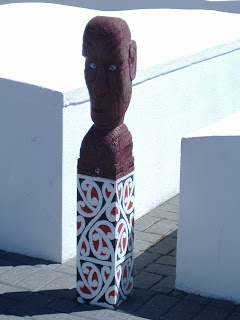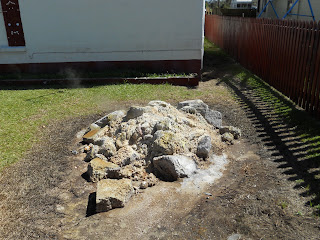In so many ways New Zealand is very British in character, but Maori culture is ever-present too. Maoris comprise about 15% of the population, making them the country's largest minority. To their credit, many modernday New Zealanders have Maori blood as a result of widespread inter-marriage, as well as the British, Irish and Scottish ancestors we expected to hear about.
You don't have to be here long, though, before the 1840 Treaty of Waitangi is mentioned, when the Maoris signed away many of their sovereign rights to the British. The differences in the Maori and English translations of the treaty's terms, as well as post-colonialism and an increased Maori awareness of the importance of their national identity, mean that Waiangi's provisions are the subject of current legal disputes, not least about rights to the foreshore and seabed. There isn't the support here for republicanism that is growing in Australia, but New Zealand is a country with vast untapped natural resources and ownership of these is obviously a potential future source of dispute. The debate is currently being won by the greens arguing against further exploitation but how long can this argument prevail?
It's not always authentic Maori artefacts that have the most impact. This reproduction Waka (canoe) really looked beautiful and the carving was so intricate.
OHINEMUTU
We asked the owner at Cosy Cottages which Maori evening he recommended, and he said we should first visit the real thing - a Maori marae meeting place. near the lake and then take one of the coach trips to see an evening of dance, traditional skills and food cooked the Maori way using a Hangi. The next photos show our visit to the real thing at Ohinemutu....
 |
| Meeting Place which non Maori are not allowed to enter |


 |
| Statues used as a compass |
St Faith's Anglican church and a military graveyard for New Zealanders who died serving their country.
Unfortunately photos are not allowed to be taken inside, but the whole of the interior is covered with tukutuku (ornamental latticework) and there is a window depicting Christ swathed in a Maori cloak and feathers, positioned to look as if he is walking on the lake.

 These guys guard the graves.............
These guys guard the graves.............The entrance to the graveyard where many Maori soldiers that died in the second world war.
Gilbert Mair ( a captain in the colonial army) is the only non-Maori to have been honoured with a chieftanship after twice saving Ohinemutu from attacks by rival Maoris.
Walking around the village there are a number of houses with the Maori statues, other community meeting places, traditional hot tubs and steaming cooking facilities that use the underground thermal activity...
Hot Pool in a garden
Steaming cooking facility in the pavement - it uses the natural thermal activity from underground
Guarding the bell for the meeting house
View across gardens - hot pool in the centre
Traditional hot tub using the heat from underground
Meeting place with shelter and views to the lake and a large car park
effects of the underground thermal activity and chemicals on the block paving
Just what I need for security gates at home
Lovely decorated house in Maori carvings
These are sizzling hot rocks click on the video below -just right to boil potatoes
Yes it is us not more statues




































No comments:
Post a Comment